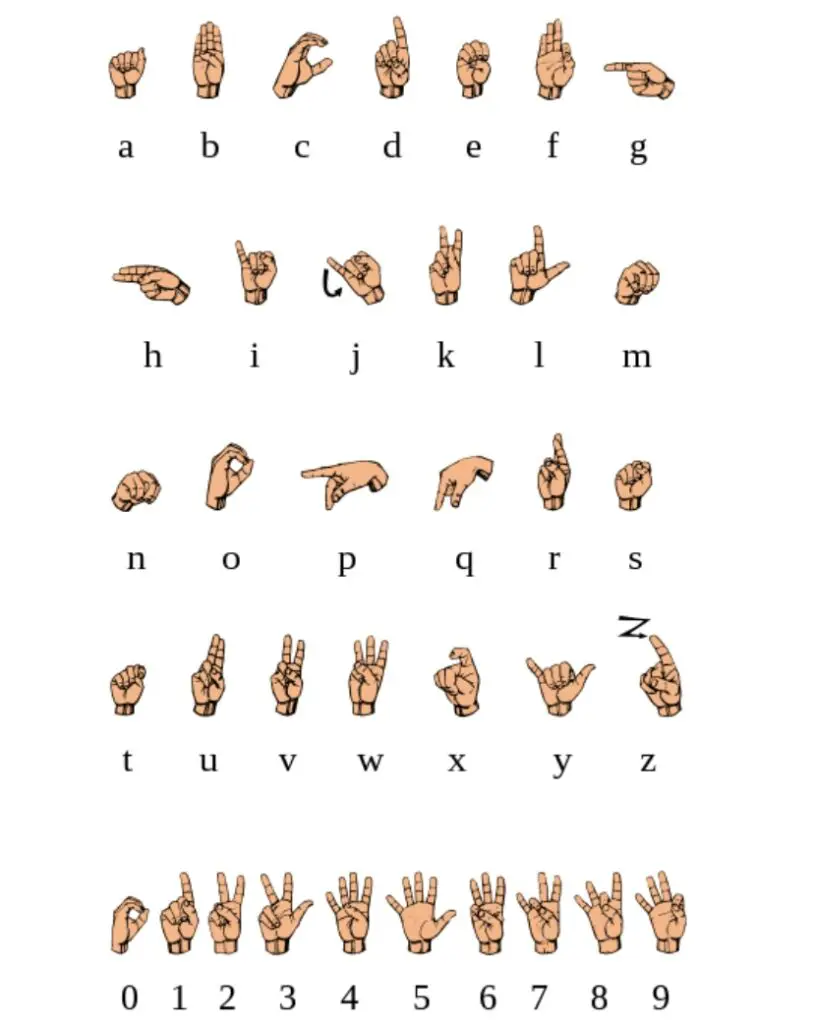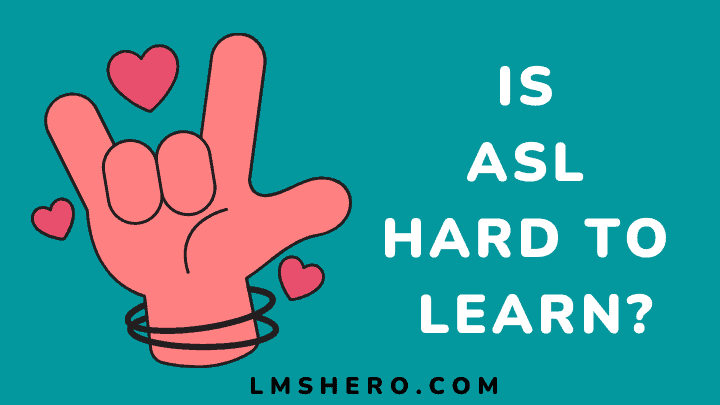Many people interested in learning American Sign Language (ASL) often wonder if it is hard to learn.
They might wonder if any special requirements must be met to learn this language.
In this article, I will provide an overview of whether ASL is hard to learn, as well as some tips to understand the basics of this fascinating sign language today.
What is ASL?
ASL stands for American Sign Language. It is a visual language that uses hand motions to communicate ideas and concepts.
It was developed in the early 1800s to communicate with those who are deaf or hard of hearing.
Today, it is used by people of all ages, from newborns learning to speak to adults who may have difficulty speaking due to impairment or limitations caused by injury or disease.
With millions of deaf and hard-of-hearing individuals using ASL every day, it’s no surprise that it has become one of the most widely used languages on earth.
What are the major reasons for learning ASL?
1. Learning sign language can make you smarter
Learning a new language like ASL can make you smarter because it offers you a chance to explore different worlds.
You get to learn about how people communicate worldwide and how they do it differently than we do in America.
And not only do you learn all of this by learning ASL itself, but also by studying other languages alongside it.
This dual approach will give your brain an unusual workout and expand its ability to think critically and creatively.
2. Communicate with diverse people
One of the major reasons for learning ASL is that it is one of the best ways to communicate in noisy areas or codes.
When you use sign language, no matter how loud or chaotic the environment may be, the person you talk to can still understand what you are saying.
Additionally, another reason to learn ASL is so that you can communicate in codes that an average person cannot comprehend.
Codes are essential for protecting your privacy and anonymity and keeping important information confidential.
So much depends on conveying complex ideas without anyone else understanding what we’re saying.
3. Learning a new language is never a bad thing
When you learn a new language, it’s never a bad thing. It can be a fantastic way to connect with people worldwide and bond over common ground.
Learning ASL is one of the best ways to improve your overall communication skills.
Learning ASL can genuinely change your life by giving you opportunities that wouldn’t otherwise exist, making signing fun and essential.
4. ASL leads to long-term cognitive benefits
ASL has no literal letters. It comprises hand motions and body language to communicate with deaf or hard-of-hearing people.
ASL is unique because it doesn’t rely on vocal cords to transmit information. This makes it one of the most critical languages for those who want to remain cognitively active.
Researchers have found that ASL leads to long-term cognitive benefits such as improved memory recall and problem-solving skills compared with other forms of communication, such as spoken English.
These benefits are likely due to how ASL engages multiple brain regions involved in these activities.
5. Enhanced spatial reasoning and ability to interpret body language
Enhanced spatial reasoning is one of the many benefits of learning ASL. It lets people see and understand complex objects in detail, better negotiate their environment, and communicate through sign language.
Someone who learned ASL could read another person’s posture and movements much more quickly than someone who does not know sign language.
This enhanced understanding of body language can help people better understand each other without speaking words aloud.
Is ASL hard to learn?
ASL is not hard to learn. It’s just different from other languages, which can initially be disorienting. But once you get over that, you’ll find that ASL is very easy to pick up.
Some people who are fluent in ASL learn it through television shows or movies using the language rather than through formal classes.
This is called “immersing yourself” in the language and helps your brain understand how to speak it well.
The best way to learn ASL is by spending time with native speakers willing to help you understand the language.
Some people also find it helpful to take classes at a community college or university. Others do not have access to these resources and must learn independently.
Understanding the basics of ASL

First, ASL is a sign language that uses hand movements to communicate. You’ll need to learn how to make the motions for each sign and then use those motions in combination with words and sentences.
Using ASL, you can spell out words from the English language with a set of 26 signs called the American manual alphabet. In ASL, 19 handshapes are used for these signs.
Let’s go over some basic tips that will help you get started:
- Make sure your mouth is closed tight when signing. If not, make sure that your lips are pressed together tightly.
- Make sure your hands are palm out at all times when signing.
- Use “fingerspelling” when it comes time to spell words for yourself or others who can’t see your face (like people in the back of a classroom). This will make learning these kinds of words much easier
There is more to ASL than just hand signals. The language has a rich history, and many meanings can be extracted from it.
It can be challenging to understand at first, but with some practice, you can get the hang of it.
Who should learn ASL?
Anyone who wants to learn American Sign Language (ASL) should be able to. ASL is a language that allows people of all ages and abilities to communicate more effectively and fluently.
Refugees, immigrants, people with hearing disabilities, people with autism spectrum disorders (ASD), veterans having trouble communicating in English, children learning to read lips, the Deaf community itself, family members providing interpreter services—you name it.
Many fields, including healthcare, tourism, and business administration, are available to people who know ASL in communities with a high deaf population.
So whether you want to communicate effectively with those around you or gain a new tool for professional success, signing knows no bounds.
Why is early learning often emphasized regarding language learning?
When it comes to learning a language or sign language, many people may advocate for early learning.
This is often because research has shown that kids who learn these skills earlier are more likely to be successful later on. There are several reasons why this might be the case.
Children’s brains are still growing and forming during their earliest years of development—which means they’re incredibly receptive to new information at this stage.
Plus, when kids start learning a second language or sign language, they’re also doing so in an environment where others around them care about helping them succeed.
They see what you do with other languages and signs and want to imitate those activities as much as possible.
This means they get extra reinforcement while their brain gets used to processing large amounts of information simultaneously.
This will carry over nicely into adulthood if they begin studying another language early on.
FAQs
How long does it take to learn ASL?
Learning ASL takes a little time (from 3 months to 3 years). However, with practice, you’ll be able to do it quickly and with minimal effort.
Can you learn ASL on your own?
Yes, there are many different ways to learn ASL on your own. You can watch online videos, read books and magazines about the language, or join a class with an experienced instructor.
Is ASL harder than spoken languages?
ASL may be more complex than spoken languages for some people, while others find it easier.
The difficulty of a language depends on the individual speaker and their level of expertise in that language.
Can non-deaf people learn ASL?
Yes, non-deaf people can learn ASL. Some of the best-known signing teachers for deaf students are non-deaf individuals.
Final thoughts
Some may find ASL hard to learn, but it is not impossible. ASL can provide an excellent opportunity to connect with family and friends in a new way and have fun while learning.
Learning ASL has many benefits, including improving communication skills and accessing a wider world.
Despite its apparent simplicity at first glance, ASL is quite complex and requires a lot of practice over time if one wants to become proficient in the language.
If you’re interested in learning more languages, having a resource can greatly help. Compare the best platforms to learn a new language now.
Thanks for reading.






